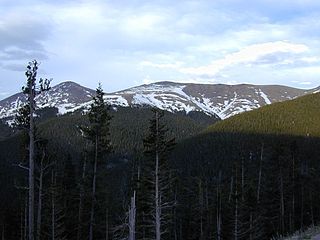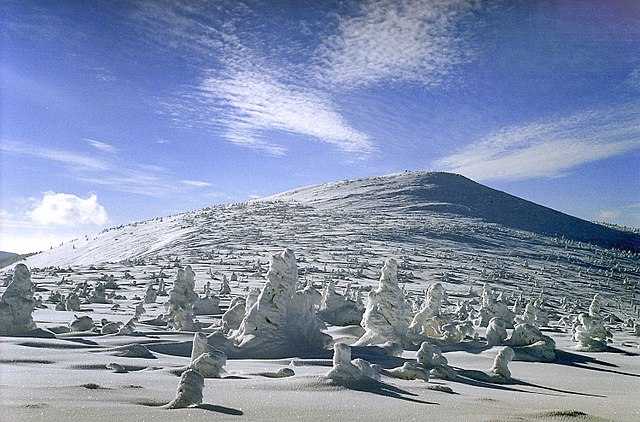Tree line
edge of the habitat at which trees are capable of growing From Wikipedia, the free encyclopedia
Remove ads
Remove ads
The tree-line or timberline is the edge of the habitat at which trees can grow. Beyond the tree-line, they are unable to grow as conditions are too bad.

There are several types of tree lines defined in ecology and geology:
- Arctic tree-line The farthest north in the Northern Hemisphere that trees can grow; farther north, it is too cold.
- Antarctic tree-line The farthest south in the Southern Hemisphere that trees can grow; farther south, it is too cold as well.
- Alpine tree-line The highest height where trees grow: higher up, it is too cold, or snow covers the ground for too much of the year. The climate above the tree-line is called an alpine climate.
- Exposure tree-line On coasts and isolated mountains, the tree-line is often much lower than in corresponding altitudes inland and in larger, more complex mountain systems, because of strong winds reduce tree growth.
- Desert tree-line The places where trees cannot grow as there is too little rainfall.
- Toxic tree-line The environment is too extreme for trees to grow. This can be caused by molten lava or hot rock (infrared radiation), any of several kinds of fumarole (steam, sulfur, acid), soil pH, low oxygen conditions, salt concentrations (as near the Dead Sea or Great Salt Lake), sulfate levels, other natural causes, or by man made pollution.
- Wetland tree-line The wettest ground on the margins of muskegs and bogs that trees can grow in, below which the ground is too saturated with water, excluding oxygen from the soil that tree roots need to grow. However, no such line exists for swamps, where trees, such as Bald cypress and the many mangrove species, are adapted to growing in permanently waterlogged soil.

At the tree line, tree growth is often not clear with the last trees forming low bushes. If it is caused by wind, these are known as krummholz, from the German for 'twisted wood'.
The tree line, like many other natural lines (lake boundaries, for example), appears well-defined from a distance, but upon close inspection, it is not that clear. Trees grow shorter until they simply stop growing.
Remove ads
Typical tree-line species

Some typical tree-line tree species (note the predominance of conifers):
- Dahurian Larch (Larix gmelinii)
- Foxtail Pine (Pinus balfouriana)
- Great Basin Bristlecone Pine (Pinus longaeva)
- Rocky Mountains Bristlecone Pine (Pinus aristata)
- Potosi Pinyon (Pinus culminicola)
- Macedonian Pine (Pinus peuce)
- Whitebark Pine (Pinus albicaulis)
- Swiss Pine (Pinus cembra)
- Mountain Pine (Pinus mugo)
- Hartweg's Pine (Pinus hartwegii)
- Subalpine Larch (Larix lyallii)
- Arctic White Birch (Betula pubescens subsp. tortuosa)
- Snow Gum (Eucalyptus pauciflora)
- Antarctic Beech (Nothofagus Antarctica)
Remove ads
Alpine tree-lines
The alpine tree-line at a location is dependent on local variables, such as aspect of slope, rain shadow and proximity to either geographical pole. Given this caveat, here is a list of average tree-lines from locations around the globe:
Remove ads
Arctic and Antarctic tree-lines
Like the alpine tree-lines shown above, polar tree-lines are heavily influenced by local variables such as aspect of slope and degree of shelter; trees can often grow in river valleys at latitudes where they could not grow on a more exposed site. Maritime influences such as ocean currents also play a major role in determining how far from the equator trees can grow. Here are some typical polar treelines:

Remove ads
References
- Arno, S. F. & Hammerly, R. P. 1984. Timberline. Mountain and Arctic Forest Frontiers. The Mountaineers, Seattle. ISBN 0-89886-085-7
- Ødum, S. 1979. Actual and potential tree-line in the North Atlantic region, especially in Greenland and the Faroes. Holarctic Ecology 2: 222-227.
- Ødum, S. 1991. Choice of species and origins for arboriculture in Greenland and the Faroe Islands. Dansk Dendrologisk Årsskrift 9: 3-78.
- Beringer, J., Tapper, N. J., McHugh, I., Lynch, A. H., Serreze, M. C., & Slater, A. 2001. Impact of Arctic treeline on synoptic climate. Geophysical Research Letters 28 (22): 4247-4250.
Remove ads
Wikiwand - on
Seamless Wikipedia browsing. On steroids.
Remove ads
